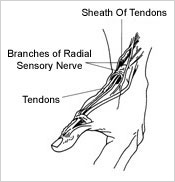De Quervain's Tenosynovitis
Many new parents suffer from chronic wrist pain caused by the awkward hand positions required to hold and care for an infant. This condition, called de Quervain's tenosynovitis and known also by many other names (see list below), can cause severe pain that it hinders the simplest of daily tasks, such as bathing, feeding, or changing a newborn baby's diapers.
- What is de Quervain's tenosynovitis?
- What causes de Quervain's tenosynovitis?
- What are the symptoms of de Quervain's tenosynovitis?
- How is de Quervain's tenosynovitis treated?
Other names for this condition
Many different medical and common names are used to describe de Quervain's tenosynovitis, including:
Medical name variants
- de Quervain's syndrome
- de Quervain's disease
- de Quervain's tendonitis or tendinitis
- de Quervain's tendinopathy
- de Quervain's tendinosis
- de Quervain's tenosynovitis
- radial styloid tenosynovitis
- wrist tenosynovitis
Common name variants
- designer's thumb
- gamer's thumb
- mommy thumb
- mother's wrist
- new mom’s syndrome
- texter's thumb or texting thumb
What is de Quervain's tenosynovitis?
De Quervain's tenosynovitis is inflammation of the tendon that runs down the forearm, through the wrist and to the thumb.

What causes de Quervain's tenosynovitis?
This injury is caused by repetitive strain on the tendon due to frequent, awkward positioning of the wrist and/or thumb. It can be brought on by repetition of many everyday activities, including:
- computer keyboard use
- fly fishing
- golfing
- hammering
- knitting
- lifting and holding babies
- skiing
- texting
What are the symptoms of de Quervain's tenosynovitis?
The chief symptom is pain in the radial side (thumb side) of the wrist. This pain is usually noticed while forming a fist, grasping objects or turning the wrist, and it may radiate out to the thumb or the forearm.
Other signs and symptoms can include:
- inflammation (swelling) or tenderness of the radial side of the wrist
- popping or snapping sounds while moving the thumb
How is de Quervain's tenosynovitis treated?
Conservative, nonsurgical treatments are tried first. These can include:
- reducing or modifying activities
- wearing a forearm spica splint
- NSAIDs (nonsteroidal anti-inflammatory drugs)
If the above measures are not effective after several weeks, gluticorticoid injections may provide pain relief. Rarely, if pain persists after non-operative measures have been tried, wrist surgery may be required.
Related content
This article discusses and illustrates de Quervain’s syndrome and other wrist conditions.
In the news

